
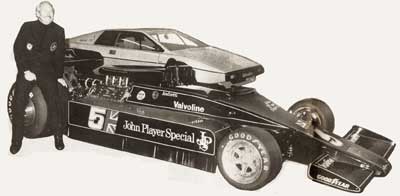
Lotus Turn the Corner
Lotus boss Colin Chapman, seated beside his two latest cars, has plenty to smile about now that road car production is running at a healthy rate. But that hasn't always been the case, as Tony Curtis explains.
Motor, 29th January 1977There must have been plenty of tense moments in the boardroom of Lotus Cars during the past four years or so. The complete renewal of a product range is always a traumatic business, but particularly so for a company with relatively slender financial resources which is tiny by automotive standards, having produced no more than 3,000 cars in its best year so far (1972). Lotus say that changing over from the old Elan +2, Elan and Europa models to the current Elite, Eclat and Esprit line-up has cost them about £4.5 million altogether – big money for a company which made a profit of around £1 million on an annual turnover of about £7 million when things went well.
But this was only the first and most routine of their problems, for in changing their model range Lotus also moved to a quite different and much more expensive section of the market. Their new cars were not intended for the moderately affluent motoring enthusiasts who had up to that time been their customers, but were aimed straight at the prospective buyers of Maseratis and Ferraris. There were many, who while conceding the excellence of Lotus design, doubted the company's ability to provide the quality and luxury required. Some eyebrows were raised therefore – including ours – when in 1974 the price of the Elite was announced as being around £6000 compared to the £3423 of the Elan +2s. The lack of refinement and poor top-gear pull of the very earliest examples raised the eyebrows even further. And to cap it all, the energy crisis arrived, knocking the bottom out of the sales of exotic cars, even those will good fuel consumption.
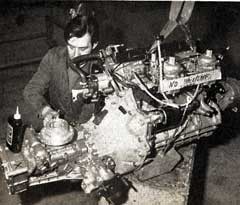
left: each of the tohc 2-litre engines is bench run for a hour before being mated to its gearbox and subjected to road test.
right: the steel backbone chassis and front suspensionBut Lotus had some thick armour to protect them against these outrageous slings and arrows in the form of Colin Chapman, possessor of one of the finest minds in the automotive business today, and his team of engineers. Their major product, the Elite, owing much more to function than to fashion, has made most of its rivals look obsolete. Light-weight, roomy – with four full seats – it has most of the refinement and performance expected of such a car, but far better fuel consumption. Its early defects soon remedied, the Elite, and its sister model the Eclat, began to look far more viable. From a loss of over £1 million in 1975 the company returned to a modest profitability in the course of last year, and with the two-seat Esprit now fully in production, it has definitely turned the corner.
Production is currently running at around 100 cars per month and is carefully planned in advance against orders and expected demand. For the first quarter of 1977, for example, around 190 cars are scheduled for Canada and the States, 40 for other export markets and 75 for Britain. In the following quarter the balance will be reversed in favour of the home market, but is hoped to sell 60 additional cars, mostly to the states. In all this Lotus are helped by the fact that their engine comfortably meets the very severe Californian and Japanese exhaust emission regulations, as well as the less stringent Federal requirements, using a catalytic converter and an air pump.
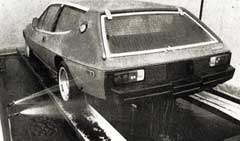
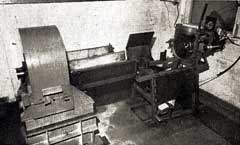
left: it never rains but it pours, an Elite undergoes a test for water-tightness in a special spray booth. middle: transmission test rig minus gearbox!
right: an Elite astride the rolling road is undergoing an exhaust emissions check.A vigorous sales drive is being organized under the leadership of Mike Kimberley, a former chief engineer, now board member and overall director of the car company. (The Lotus group, remember, includes Team Lotus who conduct the Grand Prix racing activities and a boat-making company.) A former sales manager, Graham Arnold, has been reappointed, as has Roger Putnam who is now export sales manager.
This new team has already clinched several important deals including a £300,000 sales agreement with a Middle East trading company selling to Oman, Kuwait, United Arab Emirates and Bahrain. Sales agreements for ckd (knocked down or disassembled) cars to New Zealand, Venezula and South Africa (100 cars in 1977) have been or are being concluded. Some 60 cars are scheduled to be sold in Japan this year, and the Swiss, Dutch, Belgian and German markets are all being revived. These efforts are in addition to those directed towards North America where sales are going well and new distributors are being appointed.
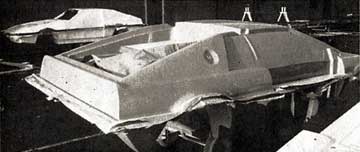
left: not-so-pretty plastic bodyshell as it emerges from its two-piece mould right: part of Lotus's 100 cars per month production.
But Lotus are also devoting a good deal of energy to the improvement of quality and to proper compliance with the complex and often conflicting construction, safety and exhaust pollution regulations of the numerous foreign countries to which they sell. Apart from the company's new emission laboratory, one of the few in the country, and commissioned in 1975, Lotus now have their own spray booth to check watertightness and a special gearbox test rig. This has its own engine and allows all the changes to be checked, including reverse.
Each car now passed through an elaborate check-out procedure. Every engine is run for an hour on the bench before being mated with the gearbox after its own battery of tests on the special rig. The complete fully assembled car is then run for 12-15 miles on the Hethel test track. A report is complied, any faults discovered are rectified, and the car subjected to a second brief road-test, this time one which takes in rough surfaces to elicit creaks and rattles, if any. After a further check there is a third road-test is any defects are found, plus a careful visual inspection of paintwork and trim. The car has to be signed off by both the road-tester and the visual inspector before it is allowed out of the factory.
Above: the comprehensive pollution analysis equipment so vital to Lotus's viability in the States and Japan.
With these efforts to improve quality and reliability, with good sales prospects for an impressive new model range, Lotus look set for a secure and prosperous future, despite the depressed state of the world's economy. For what is now Britain's largest fully independent motor manufacturer, this is achievement enough.